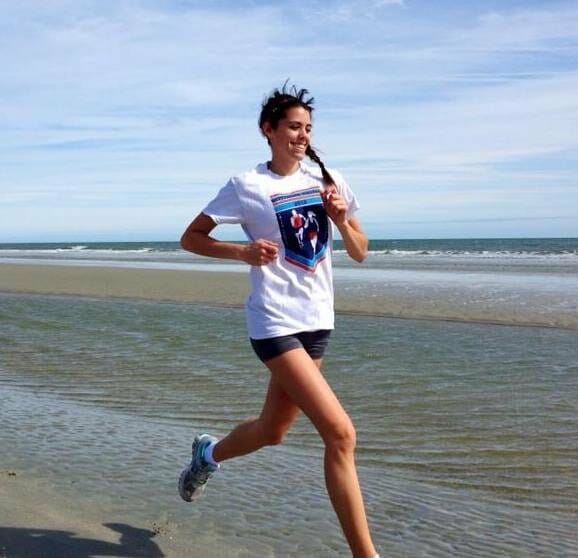Runners are a rare breed. We push our bodies to the max. We are constantly racing against some sort of watch on our wrist. The last mile just wasn’t enough…the next needs to be even better, faster, stronger. How our feet hit the ground, our breathing technique, posture, water intake, fuel, outdoor conditions, even the way our laces are tied—a million different variables are running (no pun intended) through our heads before and during even the shortest of runs.
Whether you’re Shalane Flanagan or you’re lacing up your first pair, all runners have different training methods and strategies to achieve their personal best and improve their runs, and their personalities – their natural drives and needs – are going to determine how they go about doing that.
.png)
(ABOVE: PI’s own Senior Business Operations Specialist Mike Olender kicking butt at the Boston Half Marathon 2016.)
Let’s start by looking at what The Predictive Index (PI) identifies as a person’s four primary Factors.
Dominance: The drive to exert one’s influence on people or events.
Extraversion: The drive for social interaction with other people.
Patience: The drive for consistency and stability.
Formality: The drive to conform to rules and structure.
These four PI Behavioral Factors give an enormous amount of insight into how someone will behave. And to make it even more fun, we’ve grouped thousands of possible combinations of those four Factors into 17 different Reference Profiles, which create this sort of behavioral map for different types of people. You can check out a list of all 17 Reference Profiles here.
Depending on which of these Factors are highest or lowest and which resonate more with you, this will then determine your PI Reference Profile. You can find out what your Reference Profile is by taking the PI Behavioral Assessment here. I’m what PI calls a Captain!
Let’s take a look at what each Factor is saying about you as a runner and the Reference Profiles that have a high amount of that Factor. Note, there are other Reference Profiles that may align with these Factor, but for your reading pleasure I only included one or two.
.jpg) (ABOVE: Me at my first marathon in 2017, trying to enjoy every moment of that 26.2! What a great crowd!)
(ABOVE: Me at my first marathon in 2017, trying to enjoy every moment of that 26.2! What a great crowd!)
Dominance
If the dominance Factor is what’s pushing you along during those long runs, you’re independent, assertive, self-confident, competitive, and autonomous.
With these traits in mind, you’re the type of runner who’d prefer solo runs rather than Saturday group runs. If you find yourself in the mood to switch it up and head out with a few friends, you’re driving the group and calling the shots on which routes to take. You live for that boost of adrenaline on race day and signing up for your next 10K or half marathon gives you a little high.
Back to those PI Reference Profiles (remember, you can take the Behavioral Assessment here to find out), a high Dominance Factor is seen in a Profile we call the Maverick—an innovative out of the box thinker, undaunted by failure. This high Dominance Factor can also be seen in another Profile called Captains, like me, who are problem solvers who like change and controlling the big picture.
When training for my first marathon, my Captain was always in full force—passing up group run invitations and running alongside a buddy during the race. I had found strategies and techniques that worked for me and I was steadfast on implementing them.

(ABOVE: PI’s VP of People Ops Jackie Dube had a blast running 26.2 at the Hartford Marathon 2017.)
If the whole Dominance Factor description doesn’t resonate with you, not to worry, it just means you’re more cooperative and collaborative. Group runs and training with friends is just what you need to keep you motivated. Long, relaxing runs where you can take your mind off everything is your ideal day, as you are more of a harmony-seeker.
We see this low Dominance factor in Profiles like Collaborators—friendly, understanding, and patient team players—and Altruists, a cooperative bunch with an efficient and precise work ethic.
Just remember, there’s no right or wrong Reference Profile. Mavericks and Captain aren’t better than Collaborators and Altruists. Just think of it as there are different drives and needs that are pushing us along.
Extraversion
If your Extraversion is pretty out there, or high, then your running style is more people-oriented. You’re a pretty persuasive person, so convincing your buddies to bump your 10-mile run up to 14 is just your style. You’re pretty social and enthusiastic. You’d make a great addition to any group training environment because of your ability to rev-up other runners and get them excited about their progresses.

(ABOVE: PI’s VP of Product Development, Dr. Matt Poepsel, an avid runner, competing in the 2017 Ironman Triathlon.)
Higher Extraversion can be seen in Profiles like Promoters—casual, uninhibited, a persuasive extravert with a tendency for informality—and Persuaders, socially poised risk takers who motivate team builders. PI’s VP of Product Development, Dr. Matt Poepsel, is an avid runner who has completed multiple marathons and an Ironman. As a Persuader, he says “I really love the energy in the corrals on race day. So many anxious people are talking and wishing each other to have a good race. It’s electric!”
Not resonating? Your Extroversion may be low. But that doesn’t mean you are antisocial! You’re the more analytical, pensive runner. You will spend a lot of time reflecting on past runs and on what you can improve on and change for future miles. You’re not about the politics that come with formal races and would prefer to keep your progress private and to yourself; You celebrate your own wins rather than looking to others for affirmation.
“My Extraversion is low,” says Sarah Mulvey, Research Consultant at The Predictive Index. “But I get that social fix by running with my dog or occasionally with a friend.”
The Venturer Profile possesses this amount of low Extraversion. They are self-starters, self-motivators, and risk takers with strong goal-orientation. Then there’s Craftsmen, who also have this lower Extraversion Factor. They are analytical people who produce precise and accurate work.
Patience
When it comes to Patience, runners with a higher amount of this Factor are calm and deliberate in their actions. You are acutely away of your posture while running and how your feet land on the pavement, ensuring every stride counts. You’re more comfortable with the familiar and prefer your mapped-out routes and usual neighborhood roads to new areas. Process is key, especially during strength training. Exercises are tailored specifically to your body with every physical activity outside of running—recreational hiking, swimming, basketball with friends— being deliberate and only performed if they assist in achieving your overall goals.
The Patience Factor is high with Operators—patient, conscientious, and relaxed people. Team players.

(ABOVE: For PI Research Consultant Sarah Mulvey, running is in her blood.)
Lower Patience for runners means fast-paced. You’re always on the move and looking for the latest technology to implement into your runs — the best smart watch, mapping app, hydration belt, fuel supplements. Another trait of those with lower Patience is the need for results — you want them and you want them fast. That last mile just wasn’t enough so you add an extra 5 miles to what was supposed to be your short run. The restlessness you possess forces you to constantly be looking for another race to sign-up and train for. You have an intense drive to succeed and you do. You need freedom from repetition and routine so try switching it up every once in a while, with an interval or circuit training exercises during gym days and take the opportunity to have some fun with it and map out some new routes.
Strategists exhibit this lower Patience Factor, being results-oriented, innovative, and having a strong drive for change.
 (ABOVE: Great time had by all at Jackie’s Hartford Marathon 2017.)
(ABOVE: Great time had by all at Jackie’s Hartford Marathon 2017.)
Formality
Think of those with the higher Formality Factor as the elite runners of today—Meb and Shalane —in that those with high Formality are diligent and precise. These are the runners who are following a strict training log and schedule. Their training runs are not to be taken lightly and it’s serious business. Expect a runner with high Formality to never miss a 5AM run and most likely bail on happy hour to squeeze in one last 3-miler before race day.
You can see this high Formality Factor in Scholars, who are accurate people and seek high levels of technical expertise. Specialists also possess high Formality, being highly precise people who are skeptical while respecting authority.
If you follow a less formal training regime, your Formality factor may be lower. Again, this is never a bad thing when one factor is lower than the other. As a runner, you are more tolerant of the uncertain, and you may venture down an unfamiliar trail during a long run or explore a new neighborhood when heading out. You’re more flexible with your schedule and prefer to mix it up a bit each week rather than following a training log, featuring set miles on one day and strength training on others. Putting together an impromptu run group is not unusual for you and you can easily adapt to changes and uncertainties in your training schedules and runs—for example, rain’s in the forecast forcing you to run indoors or a surprise birthday trip has you off to Maui, leaving a run or two missed.

(ABOVE: PI’s Sarah Mulvey wowed crowds during her high school running career.)
These lower Formality people are usually Individualists, who are highly independent, persistent, and results oriented. Low Formality is also seen with Mavericks, those out-of-the-box thinkers, undaunted by failure.
Whatever your natural drives and needs are, running is a personal sport. What works for one runner may not work for another. It’s all about finding your style and groove and running with it (pun intended).
 (Above: My very first 5K! Enjoy the small wins!)
(Above: My very first 5K! Enjoy the small wins!)
Want to learn more about what drives you? Check out what our Behavioral Assessment is all about and then try it for yourself to learn all about your Reference Profile!








